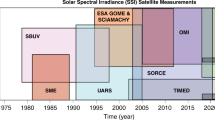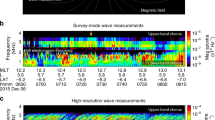Abstract
So long ago as 1934, we observed, in the night sky spectrum, radiations characteristic of the nuclei of the comets, at about λ λ 4300 and 4050 A. 1. Their origin was then unknown. The recent identification2 of cometary radiations near λ 4300 with a band of the CH molecule induced us to search systematically for the CH bands in the sky spectrum. For this purpose we used unpublished tables of wave-lengths measured by Gauzit in the ultra-violet and by Cabannes and Dufay in the blue and violet regions of the visible spectrum.
This is a preview of subscription content, access via your institution
Access options
Subscribe to this journal
Receive 51 print issues and online access
$199.00 per year
only $3.90 per issue
Buy this article
- Purchase on Springer Link
- Instant access to full article PDF
Prices may be subject to local taxes which are calculated during checkout
Similar content being viewed by others
References
Cabannes and Dufay, Comptes rendus, 198, 306 (1934); 68e Congrès des Sociétés Savantes, 66 (1935).
Nicolet, M., Z. Astrophys., 15, 154 (1938); Dufay, J., Comptes rendus, 206, 1550 (1938).
Swings, P., and Rosenfeld, L., Astrophys. J., 86, 486 (1937).
Cabannes et Dufay, Comptes rendus, 203, 903 (1936).
Grenat, H., Comptes rendus, 192, 1553 (1931).
Author information
Authors and Affiliations
Rights and permissions
About this article
Cite this article
CABANNES, J., DUFAY, J. & GAUZIT, J. CH Bands in the Night Sky Spectrum. Nature 142, 718–719 (1938). https://doi.org/10.1038/142718b0
Issue Date:
DOI: https://doi.org/10.1038/142718b0
Comments
By submitting a comment you agree to abide by our Terms and Community Guidelines. If you find something abusive or that does not comply with our terms or guidelines please flag it as inappropriate.



